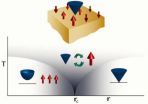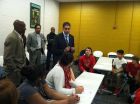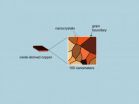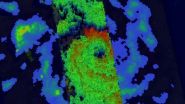(Press-News.org) TEMPE, Ariz. - If desert mirages occur on Mars, "Lake Gusev" belongs among them. This come-and-go body of ancient water has come and gone more than once, at least in the eyes of Mars scientists.
Now, however, it's finally shifting into sharper focus, thanks to a new analysis of old data by a team led by Steve Ruff, associate research professor at Arizona State University's Mars Space Flight Facility in the School of Earth and Space Exploration. The team's report was just published in the April 2014 issue of the journal Geology.
The story begins in early 2004, when NASA landed Spirit, one of its two Mars Exploration Rovers, inside 100-mile-wide Gusev Crater. Why Gusev? Because from orbit, Gusev looked, with its southern rim breached by a meandering river channel, as if it once held a lake – and water-deposited rocks were the rover mission's focus. Yet when Spirit began to explore, scientists found Gusev's floor was paved not with lakebed sediments, but volcanic rocks.
Less than two miles away however stood the Columbia Hills, 300 feet high. When Spirit drove up into them, it indeed discovered ancient rocks that had been altered by water. But to scientists' chagrin, no lake sediments were among them. Instead, scientists discovered evidence of hydrothermal activity, essentially hot springs like those in Yellowstone National Park.
But there's hope yet for Lake Gusev, thanks to a Columbia Hills rock outcrop dubbed Comanche. This outcrop is unusually rich in magnesium-iron carbonate minerals, a discovery made in 2010 that Ruff played a major role in making. While Comanche's carbonate minerals were originally attributed to hydrothermal activity, the team's new analysis points to a different origin.
Cool waters
Says Ruff, "We looked more closely at the composition and geologic setting of Comanche and nearby outcrops. There's good evidence that low temperature surface waters introduced the carbonates into Comanche rather than hot water rising from deep down."
Comanche started out as a volcanic ash deposit known as tephra that originally covered the Columbia Hills and adjacent plains. This material, Ruff explains, came from explosive eruptions somewhere within or around Gusev.
Then floodwaters entered the crater through the huge valley that breaches Gusev's southern rim. These floods appear to have ponded long enough to alter the tephra, producing briny solutions. When the brines evaporated, they left behind residues of carbonate minerals. As the lake filled and dried, perhaps many times in succession, it loaded Comanche and its neighbor rocks with carbonates.
"The lake didn't have to be big," Ruff explains. "The Columbia Hills stand 300 feet high, but they're in the lowest part of Gusev. So a deep, crater-spanning lake wasn't needed."
Today, the Columbia Hills rise as an island of older terrain surrounded by younger lava flows, Ruff says. "Comanche and a neighbor outcrop called Algonquin are remnants of the older and much more widespread tephra deposit. The wind has eroded most of that deposit, also carrying away much of the evidence for an ancient lake."
Return to Gusev?
Mars rover Spirit fell silent on a winter night in March 2010, and it has never been heard from since. Spirit left most of the Columbia Hills and other Gusev targets unexplored. Ruff says that as NASA evaluates landing sites for its new sample-collecting rover in 2020, Gusev Crater deserves serious consideration.
"Going back to Gusev would give us an opportunity for a second field season there, which any terrestrial geologist would understand," argues Ruff. "After the first field season with Spirit, we now have a bunch more questions and new hypotheses that can be addressed by going back."
Because the Mars 2020 rover mission will collect and cache samples for potential return to Earth, Ruff says, that makes going to an already visited site more important.
"Scientifically and operationally it makes sense to go to a place which we know has geologically diverse – and astrobiologically interesting – materials to sample," Ruff argues.
"And we know exactly where to find them."
INFORMATION:
Gusev Crater once held a lake after all, says ASU Mars scientist
2014-04-09
ELSE PRESS RELEASES FROM THIS DATE:
One kind of supersymmetry shown to emerge naturally
2014-04-09
UC Santa Barbara physicist Tarun Grover has provided definitive mathematical evidence for supersymmetry in a condensed matter system. Sought after in the realm of subatomic particles by physicists for several decades, supersymmetry describes a unique relationship between particles.
"As yet, no one has found supersymmetry in our universe, including at the Large Hadron Collider (LHC)," said the associate specialist at UCSB's Kavli Institute for Theoretical Physics (KITP). He is referring to the underground laboratory in Switzerland where the famous Higgs boson was identified ...
Violence intervention program effective in Vanderbilt pilot study
2014-04-09
Violent behavior and beliefs among middle school students can be reduced through the implementation of a targeted violence intervention program, according to a Vanderbilt study released in the Journal of Injury and Violence Research.
Manny Sethi, M.D., assistant professor of Orthopaedic Surgery and Rehabilitation, and his Vanderbilt co-authors evaluated 27 programs nationwide as part of a search for an appropriate school-based violence prevention program.
Their findings led to a single, evidence-based conflict resolution program that was evaluated in a pilot study of ...
Stanford scientists discover a novel way to make ethanol without corn or other plants
2014-04-09
Stanford University scientists have found a new, highly efficient way to produce liquid ethanol from carbon monoxide gas. This promising discovery could provide an eco-friendly alternative to conventional ethanol production from corn and other crops, say the scientists. Their results are published in the April 9 advanced online edition of the journal Nature.
"We have discovered the first metal catalyst that can produce appreciable amounts of ethanol from carbon monoxide at room temperature and pressure – a notoriously difficult electrochemical reaction," said Matthew ...
Novel approach to accelerate metabolism could lead to new obesity treatment
2014-04-09
BOSTON – By manipulating a biochemical process that underlies cells' energy-burning abilities, investigators at Beth Israel Deaconess Medical Center (BIDMC) have made a novel discovery that could lead to a new therapy to combat obesity and diabetes.
Published in the April 10 issue of the journal Nature, the new findings show that reducing the amount of nicotinamide N-methyltransferase (NNMT) protein in fat and liver dramatically reduces the development of obesity and diabetes in mice.
'With this discovery, we now have a means of metabolic manipulation that could ...
A bad penny: Cancer's thirst for copper can be targeted
2014-04-09
DURHAM, N.C. – Drugs used to block copper absorption for a rare genetic condition may find an additional use as a treatment for certain types of cancer, researchers at Duke Medicine report.
The researchers found that cancers with a mutation in the BRAF gene require copper to promote tumor growth. These tumors include melanoma, the most dangerous form of skin cancer that kills an estimated 10,000 people in the United States a year, according to the National Cancer Institute.
"BRAF-positive cancers like melanoma almost hunger for copper," said Christopher M. Counter, ...
UC San Diego researchers develop bacterial 'FM radio'
2014-04-09
Programming living cells offers the prospect of harnessing sophisticated biological machinery for transformative applications in energy, agriculture, water remediation and medicine. Inspired by engineering, researchers in the emerging field of synthetic biology have designed a tool box of small genetic components that act as intracellular switches, logic gates, counters and oscillators.
But scientists have found it difficult to wire the components together to form larger circuits that can function as "genetic programs." One of the biggest obstacles? Dealing with a small ...
New 'switch' could power quantum computing
2014-04-09
Using a laser to place individual rubidium atoms near the surface of a lattice of light, scientists at MIT and Harvard University have developed a new method for connecting particles — one that could help in the development of powerful quantum computing systems.
The new technique, described in a paper published today in the journal Nature, allows researchers to couple a lone atom of rubidium, a metal, with a single photon, or light particle. This allows both the atom and photon to switch the quantum state of the other particle, providing a mechanism through which quantum-level ...
Synthetic collagen promotes natural clotting
2014-04-09
Synthetic collagen invented at Rice University may help wounds heal by directing the natural clotting of blood.
The material, KOD, mimics natural collagen, a fibrous protein that binds cells together into organs and tissues. It could improve upon commercial sponges or therapies based on naturally derived porcine or bovine-derived collagen now used to aid healing during or after surgery.
The lab of Jeffrey Hartgerink, a chemist and bioengineer based at Rice's BioScience Research Collaborative, developed synthetic collagen several years ago. The lab's analysis of KOD ...
Spike in postoperative cardiac surgery deaths may be linked to 30-day survival measurement
2014-04-09
Analyzing a national database of hospital inpatient records, a team of researchers reports an expected spike in mortality six days after cardiac surgery, but also a more surprising and potentially troubling jump in deaths at the 30-day mark.
In a report on the study, they suggest that while there could be "organic" medical reasons for the extra deaths, the more likely explanation may be an unintended consequence of putting so much emphasis on marking one-month "survival" as a key measurement of surgical success.
"One possibility for the spike is that by often measuring ...
NASA's TRMM satellite sees Tropical Cyclone Ita intensifying
2014-04-09
VIDEO:
This simulated 3-D flyby animation using TRMM precipitation radar data on April 9 shows rain falling at a rate of over 99 mm/3.9 inches per hour (red) within Ita's feeder...
Click here for more information.
Tropical Cyclone Ita has been intensifying as it tracks from Papua New Guinea toward Queensland, Australia, and NASA's TRMM satellite noticed the development of an eye feature.
NASA and the Japan Aerospace Exploration Agency's Tropical Rainfall Measuring Mission (TRMM) ...




